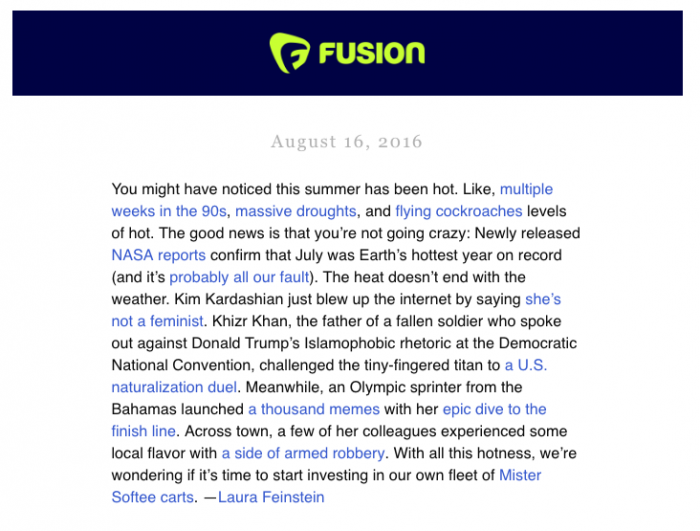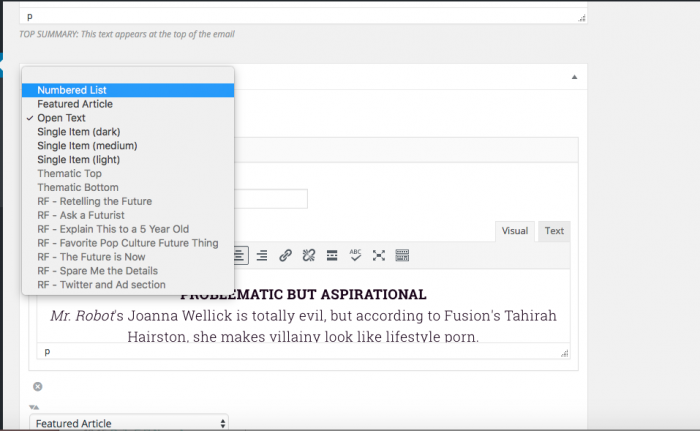
Few would argue at this point that the email newsletter isn’t one of the most powerful ways for publishers to develop strong relationships with readers. What’s less clear is the best strategy to employ within those newsletters themselves.
At Fusion, the newsletter strategy of choice has been built on the idea that its emails should feel organic and human, not robotic and automated. All three of its newsletters — the tech-oriented Real Future, its weekly thematic email, and its main daily email — feature stories that are handpicked the site’s section and social media editors. More, each email also features a brief intro from one of Fusion’s writers or social media managers, with a link to their Twitter profiles.

“There’s a thematic through-line and a coherence that you get from reading the intro and the email all the way through,” he said, describing Fusion’s approach. “This is not something you’re going to create by just sending out a email RSS feed or using an algorithm.”
Such an intensely human-based newsletter strategy does come with some drawbacks, however. One of the obvious advantages of the hands-off, RSS-based approach to newsletters is that it requires little input from reporters, editors, and social media managers. Purely from a resources perspective, it’s a tempting proposition.
Phillips said that to make the more involved approach to newsletter creation work, Fusion would have to make the process of adding and curating stories as easy as possible. To do so, Fusion’s product team earlier this year built a simple tool that lets its reporters and editors build and send the site’s newsletters from within the site’s CMS. The tool gives Fusion’s staff a live preview of the newsletter they’re putting together, letting them move around story modules based on what they want to feature or what’s performing well. (The Times of London built something similar that we wrote about last year.) They’re also able to see what the newsletter looks like on mobile screens, which is vital during a time where most email is opened on a mobile device and sites are getting the majority of their traffic through mobile.“Curating each newsletter from the ground up takes less than an hour with the way we’ve set things up,” said Chris Mainenti, senior manager for audience development at Fusion. “Based on other places I’ve been this all usually takes hours. All people need to do is change the subject line and send.”

Fusion’s focus on human citation also lets Fusion’s newsletter editors push subscribers to a variety of stories. The Real Future newsletter, for example, regularly features non-tech stories from other sections. The idea is that a reader who is normally mostly interested in Fusion’s, say, pop culture stories, will get some exposure to coverage from elsewhere as well.
“We see this as a way to bring together that some interconnected pieces of a reporting that we think tell an interesting story together, or give perspective on another big story,” said Mainenti. “It’s a powerful way to push people to read new things.”
For Fusion, these email readers have proven to be much more valuable than those coming through other platforms. Phillips said that Fusion’s email readers tend to share more of Fusion’s content, spend more time on the site, and revisit the site the most often.
Fusion’s focus on its newsletter readers isn’t surprising in today’s media ecosystem. Publishers’ ongoing reliance on traffic from Facebook in particular has been a fraught, one-sided proposition. The social network’s ability to tweak its algorithm to suppress certain kinds content has made publishers wary about the platform’s longterm viability, and pushed many to diversify their traffic sources. Email, being a comparatively open platform free of control by any one company, has been attractive for that reason. “In that sense, it’s our most valuable platform,” said Phillips.